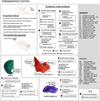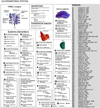Pharmacology of cognitive enhancers for exposure-based therapy of fear, anxiety and trauma-related disorders
- PMID: 25550231
- PMCID: PMC4380664
- DOI: 10.1016/j.pharmthera.2014.12.004
Pharmacology of cognitive enhancers for exposure-based therapy of fear, anxiety and trauma-related disorders
Abstract
Pathological fear and anxiety are highly debilitating and, despite considerable advances in psychotherapy and pharmacotherapy they remain insufficiently treated in many patients with PTSD, phobias, panic and other anxiety disorders. Increasing preclinical and clinical evidence indicates that pharmacological treatments including cognitive enhancers, when given as adjuncts to psychotherapeutic approaches [cognitive behavioral therapy including extinction-based exposure therapy] enhance treatment efficacy, while using anxiolytics such as benzodiazepines as adjuncts can undermine long-term treatment success. The purpose of this review is to outline the literature showing how pharmacological interventions targeting neurotransmitter systems including serotonin, dopamine, noradrenaline, histamine, glutamate, GABA, cannabinoids, neuropeptides (oxytocin, neuropeptides Y and S, opioids) and other targets (neurotrophins BDNF and FGF2, glucocorticoids, L-type-calcium channels, epigenetic modifications) as well as their downstream signaling pathways, can augment fear extinction and strengthen extinction memory persistently in preclinical models. Particularly promising approaches are discussed in regard to their effects on specific aspects of fear extinction namely, acquisition, consolidation and retrieval, including long-term protection from return of fear (relapse) phenomena like spontaneous recovery, reinstatement and renewal of fear. We also highlight the promising translational value of the preclinial research and the clinical potential of targeting certain neurochemical systems with, for example d-cycloserine, yohimbine, cortisol, and L-DOPA. The current body of research reveals important new insights into the neurobiology and neurochemistry of fear extinction and holds significant promise for pharmacologically-augmented psychotherapy as an improved approach to treat trauma and anxiety-related disorders in a more efficient and persistent way promoting enhanced symptom remission and recovery.
Keywords: Augmented relearning; Cognitive enhancer; Drug development; Exposure therapy; Fear extinction; Reconsolidation.
Copyright © 2014. Published by Elsevier Inc.
Conflict of interest statement
Drs. Singewald, Schmuckermair, Whittle and Holmes declare no conflict of interest. Dr. Ressler is a founding member of Extinction Pharmaceuticals/Therapade Technologies. He has received no equity or income from this relationship within the last 5 years. The terms of these arrangements have been reviewed and approved by Emory University in accordance with its conflict of interest policies.
Figures










References
-
- Abe K, Saito H. Neurotrophic effect of basic fibroblast growth factor is mediated by the p42/p44 mitogen-activated protein kinase cascade in cultured rat cortical neurons. Brain Res Dev Brain Res. 2000;122:81–85. - PubMed
Publication types
MeSH terms
Substances
Grants and funding
LinkOut - more resources
Full Text Sources
Other Literature Sources
Medical

